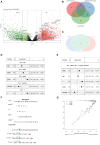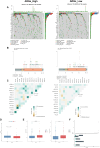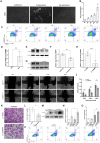Anoikis-related genes predicts prognosis and therapeutic response in renal cell carcinoma
- PMID: 40830065
- PMCID: PMC12366518
- DOI: 10.1080/07853890.2025.2548042
Anoikis-related genes predicts prognosis and therapeutic response in renal cell carcinoma
Abstract
Background: Metastasis represents the primary cause of cancer-related mortality, with a high incidence observed in renal cell carcinoma (RCC). Anoikis, a specialized form of apoptosis, plays a crucial role in preventing displaced cells from adhering to new extracellular matrices (ECM), thus inhibiting their aberrant growth. Notably, cancer cells, especially metastatic ones, exhibit resistance to anoikis. However, the exact mechanisms of anoikis resistance in RCC are not well understood.
Methods: This study integrates bioinformatics, single-cell RNA sequencing and experimental validation to investigate the role of anoikis-related genes (ARG) in RCC, with a focus on MMP9. RNA-seq data from 518 RCC patients and 71 healthy controls (TCGA-KIRC) and external validation cohorts (E-MTAB-1980, GSE22541) were analyzed to construct an ARG-based prognostic model. Single-cell RNA sequencing (scRNA-seq, GSE159115) was used to assess tumour heterogeneity, while in vitro experiments in RCC cell lines validated MMP9's impact on anoikis resistance, migration and invasion.
Results: We collected all RNA-seq and single-cell RNA-seq (scRNA-seq) data from multiple online databases and utilized these datasets to develop a novel ARG-based prognostic model called ARGs. Using Cox regression and machine learning, our model achieved a 5-year area under curve (AUC) of 0.79, surpassing existing models in predictive performance. Enrichment analysis revealed distinct immune and metabolic landscapes between ARGs high- and low-risk groups. At the single-cell level, tumour cells were categorized based on ARG expression, revealing heterogeneous anoikis resistance mechanisms. MMP9 was identified as a key prognostic gene (HR = 1.5, p = 0.016) associated with anoikis resistance and RCC metastasis. Functional assays confirmed that MMP9 knockdown increased anoikis by 59% and significantly reduced wound-healing migration by about 30% and transwell invasion by 50%, reinforcing its role in RCC progression.
Conclusions: Targeting anoikis-related genes, particularly MMP9, enhances anoikis sensitivity and reduces RCC invasiveness, offering a potential therapeutic strategy to mitigate metastasis and improve clinical outcomes.
Keywords: Anoikis; MMP9; metastasis; renal cell carcinoma.
Conflict of interest statement
No potential conflict of interest was reported by the authors.
Figures










Similar articles
-
Identification and verification of a novel anoikis-related gene signature with prognostic significance in clear cell renal cell carcinoma.J Cancer Res Clin Oncol. 2023 Oct;149(13):11661-11678. doi: 10.1007/s00432-023-05012-6. Epub 2023 Jul 5. J Cancer Res Clin Oncol. 2023. PMID: 37402968 Free PMC article.
-
Characterization of novel anoikis-related genes as prognostic biomarkers and key determinants of the immune microenvironment in esophageal cancer.Front Immunol. 2025 Jul 11;16:1599171. doi: 10.3389/fimmu.2025.1599171. eCollection 2025. Front Immunol. 2025. PMID: 40746552 Free PMC article.
-
Development and Validation of Anoiki-Related Lncrna Signature Prediction Model for KIRC Prognosis.Comb Chem High Throughput Screen. 2025;28(9):1524-1542. doi: 10.2174/0113862073271880231114100544. Comb Chem High Throughput Screen. 2025. PMID: 38305400
-
The role of c-Met in prognosis and clinicopathology of renal cell carcinoma: Results from a single-centre study and systematic review.Urol Oncol. 2017 Aug;35(8):532.e15-532.e23. doi: 10.1016/j.urolonc.2017.03.027. Epub 2017 Apr 18. Urol Oncol. 2017. PMID: 28427859
-
Cost-effectiveness of using prognostic information to select women with breast cancer for adjuvant systemic therapy.Health Technol Assess. 2006 Sep;10(34):iii-iv, ix-xi, 1-204. doi: 10.3310/hta10340. Health Technol Assess. 2006. PMID: 16959170
References
MeSH terms
Substances
LinkOut - more resources
Full Text Sources
Medical
Miscellaneous
